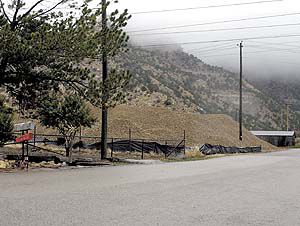| The gravel pile which is next to K.C. Williams home can be a dust problem says the resident when it is dry. |
Helper city officials addressed concerns on Thursday raised by city resident K.C. Williams regarding a rock crushing facility operated by W.W. Clyde Construction.
A similar matter came before the council in July when W.W. Clyde presented a plan to operate its crushing facility on property owned by Bob Hoggatt. The council directed the construction firm to bring the matter to the planning and zoning board. After learning that the operation on the Hoggatt property was not likely to be approved, W.W. Clyde changed its plans and announced that it would operate the rock crushing facility on land owned by Utah Railway.
Under Helper’s zoning ordinance, operating the rock crusher is permitted in the rail yards, which are zoned as industrial. However, the operation is still required to comply with applicable regulations which apply to air quality, noise control and transportation.
Williams cited environmental and health issues and requested the city’s assistance in ensuring that the construction firm come into compliance with federal, state and local statutes governing rock crushing operations.
Councilmember Dean Armstrong noted that he had visited the area and observed a lack of compliance by W.W. Clyde. He Armstrong noted that trucks were not covered and exceeded the maximum load height for uncovered loads.
Transportation regulations stipulate that uncovered loads must be loaded no higher than six inched below the top of the truck. Any loads which exceed that height must be covered.
While he conceded that he may have observed a few isolated instances of noncompliance, Armstrong insisted that there was a problem with the transportation.
Armstrong also observed that two sides of a gravel pile were not adequately watered and that the pile came within a few feet of the property line. He said he observed high winds blowing dust from the pile and onto adjacent properties.
Jason Whitman, who is overseeing W.W. Clyde’s construction of the Helper interchange, said that the company was willing to work with property owners to resolve any issues.
Whitman said that gravel crushing operations would conclude on Oct. 6 and the gravel pile would be removed as it was needed. He said that the materials should be cleared from the railroad property in November or December.
The pile was placed close to the property line because of space constraints, said Whitman. He added that all permits were in place and that any instances of noncompliance were isolated instances.
He said that the company was looking at other options to finish acquiring the materials for the interchange.
“We didn’t try to put anyone out,” said Whitman. He agreed to make restitution to Williams, offering to assist in the cleanup of dust which has covered Williams’ property.
After hearing the matter, the mayor appointed Councilmember Bob Farrell to act as an intermediary to help resolve issues between the construction firm and adjacent property owners.
In an unrelated matter, the council heard a report from Armstrong regarding the status of the Community Development Block Grant it received to renovate the Rio Theater.
Armstrong explained that he went to a meeting regarding the grant and was given new information regarding repayment status and options. As part of the stipulations for the grant, the city was required to create three full-time jobs in association with the theater.
Last year, the city reported that it was not going to be able to meet that requirement and the grant administrators requested that Helper refund the grant. The city will not be eligible for future CDBG grants until the grant is paid in full, said Armstrong.
However, some changes were presented to Armstrong regarding the terms of repayment. He said that if the city could justify one of the employees, it may be able to keep a portion of the original grant. Armstrong said that one employee hired in association with the theater was worth about $35,000 of the grant.
Armstrong also reported that he was told the employees didn’t necessarily have to be on city payroll. Rather, he said that as long as employment could be attributed to the theater, the job could be considered as fulfilling the grant.
That is a change from what city officials have been told in the past. Mayor Mike Dalpiaz and Recorder Jona Skerl both said that they had been led to believe the employees needed to be on the city’s payroll in order to fill grant requirements.
“We don’t have a tree to pick this money from,” said Dalpiaz, noting that the city was unable to pay back more than a small fraction of the grant and that it was working to pay it off slowly.
The mayor said he would consult with Senator Mike Dmitrich regarding the matter and request the lawmaker’s assistance in helping resolve the situation.

